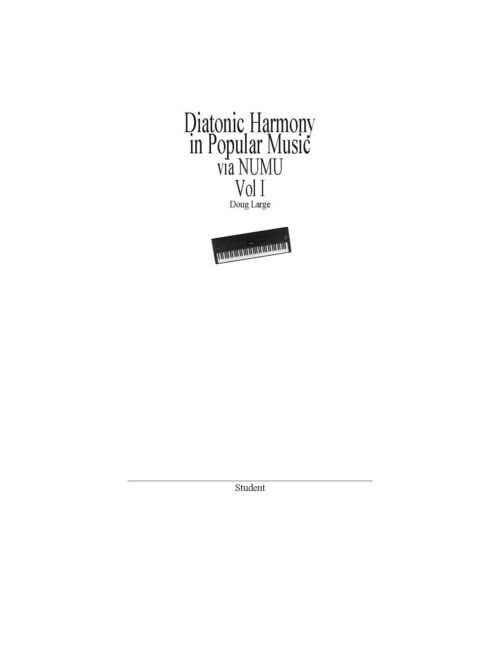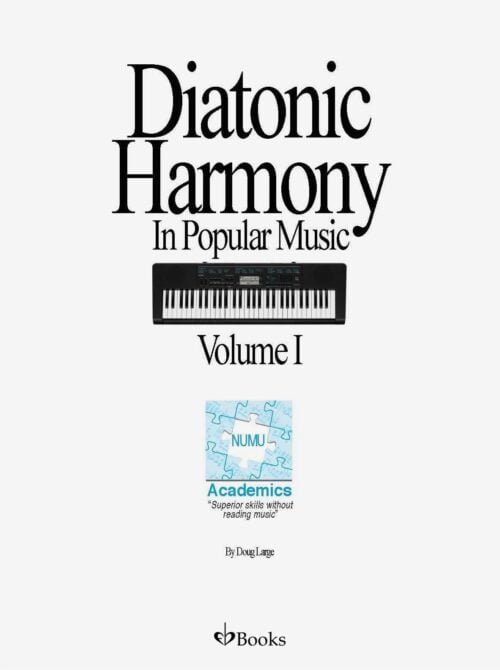My focus is not to train students to just reproduce prepared material. I want students to understand what they play, not just play it.
When instructing beginners or introducing a new subject — dumb it down, leave stuff out. Make it easy as possible. Once the student acquires some skill & confidence, they will be emotionally ready to progress to more challenging study. Making it difficult in the beginning can discourage and invite students to quit.
If the student has a sincere desire to learn, but is having trouble, it’s my responsibility to find/create an alternative method that will reach them.
Table of Contents
Why No Standard Notation?
As a music educator, my calling is not to prepare wind instrument players, or a choir, to reproduce prepared material – the “Establishment” music paradigm. I’m usually found preparing string instrument players (Guitar, Bass, Keys) to work with chords – the “Contemporary” music paradigm. Establishment music and Contemporary music are radically different paradigms.
Establishment Music Paradigm
- Wind instruments: voice, clarinet, trumpet, trombone, etc
- Acoustic
- Monophonic – single melody line.
- Purpose: reproduce prepared material
- Large ensembles
- Instrumental compositions
Contemporary Music Paradigm
- String instruments: keyboards, guitar, elec. bass
- Electric
- Polyphonic – chords
- Purpose: accompaniment
- Small ensembles
- Solo vocal compositions
Establishment music & Contemporary music are very different and need to be taught differently. Sadly, many music educators have no experience in popular music. As a result, they can’t imagine an environment without prepared material & standard notation.
Instructor Preparation
Establishment Music Paradigm
- Learn to read standard notation
- Learn to sing and/or play notes on several wind instruments
Contemporary Music Paradigm
- Learn to read & write chord charts
- Learn to play basic chords on guitar & keyboards
- Learn fundamentals of harmony & composition
- Learn fundamentals of improvisation
- Learn fundamentals of instrument amps & PA systems
Methodology
“Visualize what it would look like…. if we began teaching children to read and write as a means of learning to speak…Would that feel strange to you, teaching an infant or very young child to speak through the use of reading and writing? And yet this is exactly how music is taught to children in much of the West today” – Dave Wish – Founder – Little Kids Rock
“(in the future) learner-centered class the vast majority of musical work will be done aurally by students. Western staff notation will rarely be necessary and can be addressed when, and if, students find the need for it. Traditionally, music education has taken the stance that the abilities of reading and writing musical notation are absolutely essential to music making. This tends to be true for only certain musical styles, practiced in specific ways — these being the styles and ways that are most common in schools in the United States. We do a disservice to students when we so overemphasize the written aspects of music that they begin to see notation as fundamental to understanding what music is about” – Dr David A. Williams – University of South Florida
Music existed long before 900AD when standard (Western staff) notation first began to be developed. How did they learn before that? They obviously had a different method.
In fact, many famous musicians/composers haven’t employed traditional notation. The list includes early Classical music figures; Francesco Landini, Antonio de Cabezon, & John Stanley – Jazz greats; Dave Brubeck, Errol Garner, Earl Hines, Jimmy Smith, Chet Baker, Sidney Bechet, Charles Mingus, Joe Pass, Wes Montgomery, & Django Reinhardt – Film composers; Hans Zimmer, Danny Elfman, & Randy Newman; Broadway composers; Lionel Bart (Oliver), Harvey Schmidt (The Fantasticks), Jerry Herman (Hello, Dolly) Claude-Michele Schonberg (Les Misérables), Charlie Chaplin, Anthony Newley, Irving Berlin – and virtually every Pop & rock musician & composer of the last 60 years.
Considering the list above, there MUST be another way to learn & communicate music – in fact considering the success of these people – it’s reasonable to believe there might be a “superior” method.
Formulas
Music is actually based on simple interval formulas – numbers (see: Pythagorean Monochord). These formulas are key independent (movable “Do”) concepts, abstract theoretical principles that remain consistent for every scale, chord, & key.
Standard music notation cannot communicate formulas. It cannot communicate an arbitrary musical idea, concept, or abstract theoretical principle. It must give a specific example. Harmony is traditionally taught with copious specific examples, hoping the principle will sink in.
NUMU (number music)
On the other hand, NUMU is easy, intuitive, and was created specifically to illustrate interval formulas. I believe it’s far better to teach students a few simple formulas – that impart understanding – instead of requiring them to memorize hundreds of note combinations – that don’t impart understanding
In Closing
Once any musician, regardless of instrument or genre, understands even a little harmony (how chords are built) & composition (how chords fit together), it allows them to see behind the curtain and grasp the inner workings of music. They can understand what they play, remember it easier, play it better, change their part, change the key, compose, & improvise.
My focus is not training students to just reproduce prepared material. I want students to understand what they play, not just play it.
I want to set them free






Leave A Comment